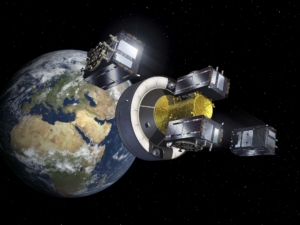STRUCTURE
HELMET intends to provide a modular high integrity and accuracy EGNSS architecture for land transportation and UAV applications supporting rail and road. This main objective is pursued by the 4 technical WPs.
Beside these WPs, two additional WPS have been individuated to cover the exploitation and standardisation roadmap (WP6), and the dissemination and communication (WP7). Finally, a management WP (WP1) is foreseen to include all those tasks devoted to the project coordination and management. A schematic overview is depicted in Figure 15. The first phase of HELMET is devoted to define the user requirements for road and rail and UAV (supporting the first two ones) applications and system requirements (including multimodal AIMN and multi-sensor OBU platform) (WP2).

This activity will firstly identify the user requirements and the operational use cases in cooperation with the rail, road and UAV stakeholders. In this sense, the presence of the advisory board is a key element and its deep involvement since the project beginning. After that, the system requirements (functional, performance, security and RAMS) and their harmonisation will be defined, and they will be the drivers for the architecture design (WP3), including both AIMN and MOBU platform (in particular focusing on data-fusion and multi-sensor FDE ARAIM algorithms). The design phase will be split into two phases: preliminary design and detailed design. In the preliminary design, the functional architecture and the interfaces will be defined in order to map the system requirements into design requirements for the two HELMET main subsystems. In the second design phase, the functional architecture will be mapped into the physical architecture with the detailed definition of all building blocks. The third stage is represented by the system development and testing (WP4).
This phase will include development of each subsystem architecture together with the unit and integration testing of the final HELMET architecture. Finally, the proof of concept (WP5) will be performed by using both laboratory and field tests. Standardisation, Certification aspects are fundamental for the development of a large scale application as the rail and automotive ones.
WP6 will address such themes in an harmonised way, promoting HELMET architecture and augmentation messages within existing GNSS Standardisation Organisations (e.g. RTCM SC-134 committee) and single sector bodies (ERTMS for rail, SAE for automotive). Regulation will be tickled contacting relevant stakeholders (e.g. ERA for rail and national ministries of transport). A harmonised business model, taking into account the common role of some service providers (e.g. multimodal augmentation service providers) will be elaborated.

A detailed revenues mechanism will be defined, and relevant business plan derived (WP6). In order to support the development of the simulation and verification environment for HELMET architecture, and to ensure interoperability of the solutions and tools provided by each partner, HELMET will rely on the implementation of a MBSE approach. The advantage of such approach for HELMET is twofold.
On the one side, it will ensure interoperability of the solutions provided by the various laboratories/entities involved in the project. On the other side, it will also ensure that the simulation infrastructure can be maintained, and that it can evolve in the future, including EGNSS evolutions.
Field tests and the final demo will be carried out in the EMERGE test-bed in L’Aquila (Italy).
This test-bed has unique features: it is deployed in an urban environment with a 5G network and it has five vehicles already equipped with SAE L3 automated driving requirements.
WP1 – Project Management
- to ensure efficient coordination of the project together with the Technical Management Team;
- to coordinate the technical work of the various WPs so as to integrate, control and maintain the overall objectives and scheduled deliveries of the project;
- to ensure efficient management of common consortium activities;
- to ensure efficient overall administrative and financial management of the project;
- to manage the internal and external communication, assessing and reporting on the progress made to EC and to partners;
- to perform risk management, defining the risk mitigation strategies in order to achieve the complete project objectives in time.
WP 2 – User and System Requirements
- to define use cases for the HELMET project – most demanding operational scenarios and use cases will be considered;
- to identify the HELMET user operational, functional, RAMS, security and regulatory requirements for rail, road and UAV (supporting rail and road) applications;
- to perform the trade-off analysis for user requirements definition, taking into operational and overall technical feasibility and then to develop HELMET CONcept of OPerationS (CONOPS);
- to consolidate and justify critical system requirements (functional, operational, RAMS, security and regulatory) related to the ERTMS GNSS-based VB concept and further to utilize the similarities for the specification and harmonization of system requirements for self-driving cars with GNSS-based ACSF. Same approach will be followed for UAV.
- to perform an overall HELMET system technical and cost risk identification, analysis and assessment including comparative risk analysis among rail, road and UAV application segments;
- to define and establish the HELMET subsystem (AIMN/MOBU) requirements (functional, operational, RAMS, security and regulatory) for rail, road and UAV (supporting rail and road) applications.
WP 3 – Methodology Development of the GNSS Characterization in the Railway
- to define use cases for the HELMET project – most demanding operational scenarios and use cases will be considered;
- to identify the HELMET user operational, functional, RAMS, security and regulatory requirements for rail, road and UAV (supporting rail and road) applications;
- to perform the trade-off analysis for user requirements definition, taking into operational and overall technical feasibility and then to develop HELMET CONcept of OPerationS (CONOPS);
- to consolidate and justify critical system requirements (functional, operational, RAMS, security and regulatory) related to the ERTMS GNSS-based VB concept and further to utilize the similarities for the specification and harmonization of system requirements for self-driving cars with GNSS-based ACSF. Same approach will be followed for UAV.
- to perform an overall HELMET system technical and cost risk identification, analysis and assessment including comparative risk analysis among rail, road and UAV application segments;
- to define and establish the HELMET subsystem (AIMN/MOBU) requirements (functional, operational, RAMS, security and regulatory) for rail, road and UAV (supporting rail and road) applications.
WP 4 – System Development & Testing
- the procurement of the external tools, hardware and services required for the prototype development;
- the development of the component at subsystem level with the unit testing procedure;
- the system integration with the integration testing procedure;
- laboratory system testing.
WP 5 – Proof of Concept
- to perform the field testing of the HELMET integrated platform in the EMERGE test bed in L’Aquila;
- to provide the field testing verification matrix of each subsystem (AIMN and MOBU) and the integrated platform;
- to carry out the final validation of the HELMET platform through an independent external assessor (Stanford team) with MAAST software.
WP 6 – Business Plan & Roadmap for Exploitation and Standardization
This WP will provide:
- A clarification of ASIL determination process using harmonised automotive risk and safety requirements;
- A proposal of harmonised standards for automotive and rail within relevant SC-134 WGs;
- definition of the certification and authorization processes of GNSS based safety-related systems in rail and automotive sectors;
- the definition of the roadmap for the exploitation of HELMET solution within the rail and road;
- business plan update, through the development of relevant CBA (Cost Benefit Analysis) and NPV (Net Present Value) analysis.
WP 7 – Project Dissemination and Communication
- to raise awareness and get feedback about the HELMET results in the railway, automotive and drone and in the satellite communities;
- to promote HELMET among the standardization bodies and other decision-making entities;
- to share know-how among researchers and provide further opportunities for cooperation;
- to secure the involvement of important users and stakeholders;
- to engage with end users and wider stakeholder communities;
- to promote HELMET within GNSS conferences and workshops;
- to organise events and carry out dissemination activities toward institutional actors.
